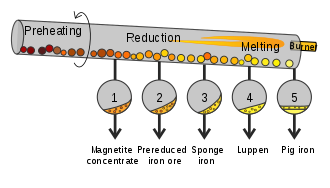
explanation of Rotary kiln
A rotary kiln is a pyroprocessing device used to raise materials to a high temperature (calcination) in a continuous process. Materials produced using rotary kilns include:
1:Cement
2:Lime
3:Refractories
4:Metakaolin
5:Titanium dioxide
6:Alumina
7:Vermiculite
8:Iron ore pellets
Principle of operation
The kiln is a cylindrical vessel, inclined slightly to the horizontal, which is rotated slowly about its axis. The material to be processed is fed into the upper end of the cylinder. As the kiln rotates, material gradually moves down towards the lower end, and may undergo a certain amount of stirring and mixing. Hot gases pass along the kiln, sometimes in the same direction as the process material (co-current), but usually in the opposite direction (counter-current). The hot gases may be generated in an external furnace, or may be generated by a flame inside the kiln. Such a flame is projected from a burner-pipe (or "firing pipe") which acts like a large bunsen burner. The fuel for this may be gas, oil, pulverized petroleum coke or pulverized coal.

Construction
The basic components of a rotary kiln are the shell, the refractory lining, support tyres (riding rings) and rollers, drive gear and internal heat exchangers.
The prev one: High Friction Surfacing bauxite – Definition and Application
The next one: Difference Between Bauxite and Aluminum
24-HOUR SERVICE, SPECIALLY FOR YOU
Email: info@sinocean.ltd
Tel: +86-371-55970121
Fax:+86-371-66684099



